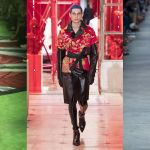
The Kimono's effect on fashion
History of an endless passion
October 19th, 2018
The kimono is an amour fou. It is a stubborn, rooted, atavistic passion, destined to rekindle cyclically, in a loop of pure beauty that the fashion world cannot ignore. Regal, hieratic, refined, exotic, minimalist, boho, trendy.
Throughout history the kimono has had more or less fortunate periods, remaining, however, a latent reference, waiting patiently, like the embers under the ashes, which a gust of wind or style brought them back on the catwalks and in our wardrobes. From Poiret to Yamamoto, from Galliano to Saint Laurent, from Thom Browne to J.W. Anderson, no designer was able to ignore the charm by proposing it, each in its own way, even in the last seasons. Despite being very current, loved by stars like Florence Welch and Beyoncé, who, still pregnant with twins, has shown off one by Gucci at a basketball game, this key piece of the Japanese costume has an ancient history.
For a long time the term "kimono", literally "thing to wear", indicates a generic item of clothing and takes on its present meaning only during the mid-nineteenth century. Originally for the aristocracy, it is a kind of petticoat; it becomes a real dress only when it is adopted by the samurai and then by the rest of the population. Influenced by the traditional costumes gifts of the Mongol people, Manchi and Han Chinese, takes on the typical "T" shape in the Edo period, between 1603 and 1868: a silhouette with straight lines that reaches the ankle, with very wide sleeves at the wrists, wrapped around the body and fastened by a wide belt, knotted at the back, called obi.
The types of kimono are different, all with specific rules and functions, but almost always combined with traditional footwear, geta and zori sandals and tabi, socks that divide the big toe from the other fingers (Also famous for having inspired the Tabi Boots of Margiela). A fun fact? Men's kimono are available in various sizes, but all women's ones are substantially one size and are adapted to the various shapes and sizes of the body by folding or bending the fabric appropriately. If the shape remains more or less static, to make each item unique, the colors and the workmanship of the fabric are precious, not just an aesthetic element, but an indicator of social status. In the early 1900s, the opening of the country to international trade and the success of world fairs, which spread even the most exotic objects everywhere, sparked the passion for Japan and its culture in Europe: Japan. The kimono inspires painters like Toulouse-Lautrec, Alphonse Mucha and Gustav Klimt, but also fashion designers like Paul Poiret and Madeleine Vionnet who start playing with volumes, fabrics, overlays and oriental embroideries. Commonly used for dressing gowns, the new long and fluctuating shapes are definitely established in the 20s and 30s thanks to Hollywood, worn by silent movie divas like Louise Brooks and Clara Bow, later by iconic stars like the enigmatic Marlene Dietrich, from Liz Taylor or Alain Delon in the sixties, starring in Star Wars, Kim Rossi Stuart in karateka version in 80s Il ragazzo dal kimono d'oro, up to Lucy Liu samurai-girl in the movie Kill Bill or the beautiful Memoirs of a geisha of our time.
The passage is short from the cinema to the catwalks. Rei Kawakubo, Yohji Yamamoto, Junya Watanabe and Issey Miyake, despite an avant-garde approach to clothing, have always played with the kimono; Balenciaga began his research almost immediately on the volumes and proportions of the sleeve of this Japanese cult item, which he used for the first time in 1939; John Galliano deconstructs it and reassembles it continually, he did it when he was from Dior and continues to do so now at Maison Margiela; Dries van Noten loves to blend it with an old Hollywood mood; while since he arrived from Gucci, Alessandro Michele has always included among his collections at least one garment inspired by the most iconic piece of Asia. If on the catwalk the kimono is often synonymous with uniqueness and elegance, hovering between a futuristic style, a ghost in the shell and a memory of a refined era, in the streets it goes open, deconstructed, like a jacket, with jeans or shorts , a bit 'boho, as taught by the Coachella Festival. It is in this version that celebrities love it, it girl and it boy like Kanye West and Kim Kardashian, Gigi Hadid, Rihanna or Madonna. And you? Are you also in love with the kimono? If you are not yet, you will be after seeing our gallery on the coolest fashion item of Japan.

























































































































































